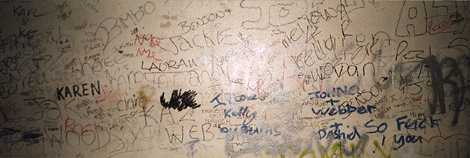
Even domestic homes may have one on a postcard or tucked away in the kitchen on the side of a brown sauce bottle!
As the wheels of government turn inside the buildings, so do the spools of 35mm cameras as the members of the Parliamentary Photographic Group put aside red boxes for those of a green or yellow nature.
Open to both Lords and Commons, the society has a thriving if somewhat loosely bonded membership of about 35 active photographers who contribute to the annual Parliamentary Photographic Exhibition held in February.
Sponsored by Kodak, the exhibition then passes to the the RPS and The National Museum of Photography, Film & Television at Bradford before touring.
"Although we have tried to have meetings outside and at other times", says Sir Jerry Wiggin, "it's very difficult to get attendance as everyone is so extremely busy".
The latest competition for the society was set by Photon on the theme of The Writing on the Wall. The entries, to say the least, were divergent on this theme with interpretations being taken literally, metaphorically and as a combination of the two.
Mitchell's shot of a woman literally writing on the Great Wall of China was both humorous and in terms of composition, excellent with the subject in the foreground and the Wall snaking away into the distance behind her.
The standard amongst the members is very high. Baroness Wharton, for example, has her own dark room where she works in both colour and B&W.
"Photography is my passion", she says. "Each of my two enlargers has a 12 x 16 Nova tank complete with chemicals, so what more could I possibly want?"
For her work she uses a Canon EOS-5 with a 35-100 lens. Film varies from Kodak Gold 100 and Ilford XP-2 to Kodak T-Max 400 downrated to 200.
For the competition her b&W prints were developed in T-Max developer and presented on Ilford Multigrade RC.
Another entry from the Lords was from Lord Crathorne, who offered a print of a visiting party with heads down walking through the gate of a Czech concentration camp with the words "ARBEIT MACH FREI" (Work Creates Freedom) above them.
"This was taken on a parliamentary visit, and on trips such as this I take a lot of pictures, few of which are 'arranged'.
"I bought my Pentax SLR in 1977 and this shot was taken using a 30-70mm lens, Kodachrome 200 at �8, probably around 1/125 of a second."
"I've always loved taking pictures using the camera for a visual record - a form of diary - and partly because I have an interest in composition as I used to work in the impressionist picture department of Sotheby's".
Edwina Currie didn't let us know whether she had bought her camera from Sotheby's but the Kodak Retinette 1B is quite likely to turn up at that organisation's second hand camera auctions.
Introduced in 1963 it was similar to the folding Retina cameras, but it had a less advanced specification; production ceased in 1967.
Mrs Currie's picture shows a vine in full bloom laden with grapes. The wall directly below, however, has had the plaster removed to show the brickwork beneath needing attention.
However, modern technology has also arrived at Westminster, and one of the members using it to the full is Jerry Wiggins.
"For the Writing on the Wall competition I had negatives and slides put on a Kodak Photo-CD disk, and I then manipulated them using Photoshop on my computer, and printed them on an Epson Stylus Colour bubble jet printer.
"The problem I have is that most of the picture files finish up too large to get on to an ordinary floppy disk. I have not ventured into expensive solutions."
By limiting the size and resolution Sir Jerry was able to send us a disk with the image saved as a JPEG file. His original slide was shot with a Nikon F90 using a 28-85mm zoom and Kodachrome 64.
Some members come from constituencies that contain wonderful opportunities for landscape photography. Not so Nick Raynsford, who represents Greenwich, but as a photograher he is not complaining.
"My constituency is full of fascinating sites and places to photograph. The Thames riverbank is a real favourite, containing an amazing mixture of wharfs, factories, derelict sites and historic buildings.
"One of my entries was taken on a summer evening with the light giving an added vibrancy to the Wimpey sign along the wharf. But is was the graffiti which made the image irresistible!"
Nick had noticed that the spelling was incorrect - perhaps a sign of the decay in educational standards? Either way as an entry for Writing on the Wall it was ideal. It also demonstrates that to take the pictures that count, you need to be constantly searching and going where others never think of visiting.
Steve Newman